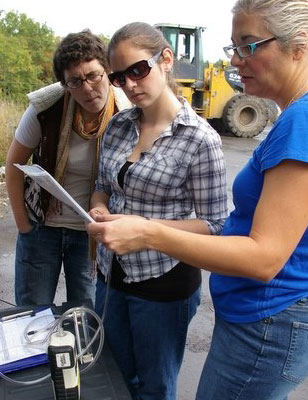Biodiesel Research by Nora Traviss Receives Prestigious Grant

Combustion of petroleum diesel fuel is a major source of air pollution. A project led by Dr. Nora Traviss, Assistant Professor of Environmental Studies, examines the use of biodiesel, a fuel made from renewable raw material, as an alternative. While diesel-related air pollution has been well-studied, little is known about the impact of real-world biodiesel combustion on important particle characteristics such as size, shape, number and composition. Particulate matter is an air pollution term for a mixture of solid particles and liquid droplets found in the air. The pollutant comes in a variety of sizes and can be composed of many types of materials and chemicals. Particles that are small enough to be inhaled have the potential to cause health effects.
While there is a considerable body of evidence on the negative health effects of petroleum diesel exhaust exposures, there has been little research examining the effects switching to biodiesel may have on worker health and the local environment.
Keene State College students from Environmental studies, Chemistry, Physics and Biology have been collecting data to assess the physical, chemical and biological characteristics of particulate matter generated by diesel and biodiesel fuels in a real-world setting using heavy-duty diesel engines.
The results will increase understanding of the benefits and challenges of using biodiesel fuel as a substitute to reduce particulate matter pollution. The work is funded by the National Institute of Environmental Health Sciences under what is called an Academic Research Enhancement Award, also known as an R15 grant, which supports small research projects up to three years. The project will be completed by 2015.
There is growing interest in the use of biodiesel to replace petroleum diesel fuel. Biodiesel has been suggested to pose less risk to human health and the environment.
In recent years, multiple tailpipe emissions studies have indicated biodiesel use reduces emissions of carbon monoxide, particulate matter, and total hydrocarbons; however it remains unclear if emissions reductions measured at the vehicle tailpipe in a laboratory setting will translate to exposure reductions of particulate matter and other pollutants under conditions of real-world operation. In 2008 U.S. biodiesel production volume expected to approach 600 million gallons. This increase in production has occurred despite a scarcity of human exposure and health effects research.
Measurement of real-world exposures provides valuable data to evaluate potential health risks to workers and the local public, and is often a weak link in the risk assessment process.
Fine particulate matter generated by diesel combustion can penetrate deep into human lung tissue, causing a range of acute and chronic cardiopulmonary health impacts. A 2006 Keene State College study of biodiesel use in heavy equipment at the Keene Recycling Center found that a 20 percent biodiesel blend reduced airborne fine particulate matter exposure concentrations by approximately 60 percent. However, 20 percent biodiesel blend use also resulted in a significant increase in organic carbon concentrations.
Students conducted initial data analysis on particulate matter concentrations, indoor air quality, and vehicle activity at the Keene Recycling Center. Students presented their findings to the public at the Keene State College Academic Excellence Conference in Spring 2010.
“There are certainly a variety of types of biodiesel fuels you can use,” said Jim Kraly, Assistant Professor of Chemistry also working on the project.
“There’s a need to understand potential negative effects use of those fuels can have. Part of what’s exciting about this study is to be able to characterize exhaust produced by different types of biodiesel. We may realize certain types of fuels are releasing more or less levels of toxic chemicals.”
To measure the health effects of biodiesel fuel, students began working last summer culturing healthy, non-contaminated human lung cells in the lab. “We’re measuring toxicity by cell mortality using different particulate matter concentration,” Traviss said.
Biology major and senior Sarah Maichel wrote the protocol to culture the lung cells. She established a sterile technique to grow the cells on ice and spin them into pellet form to calculate their density and measure the rate of mortality per unit concentration. “What’s novel is that these particles were collected in a real-world scenario at the Keene Recycling Center,” Maichel said. “These are particles people are actually breathing.”
Senior Environmental Studies major Alison Asmus has worked on biodiesel research with Traviss since her freshman year. Her role this year was to run statistical tests using samples taken in 2011 of distribution on two fuel types of different metals, including aluminum, iron, nickel, copper, zinc and led. “These are among the metals that showed up the most in both fuels,” she said. More metals analysis is part of the project.
“To get students involved in undergraduate research using multiple instruments while being part of a collaborative project with regional importance and timely relevance is an important part of what we do at Keene State,” Kraly said. “To be able to fund (projects like this) is a fantastic motivator.”
Dr. Traviss’ biodiesel research program is supported by National Institutes of Health (NIH) Academic Research Enhancement. Previous NIH support included awards through Dartmouth College’s Center for Lung Biology Research and NH-INBRE programs.





